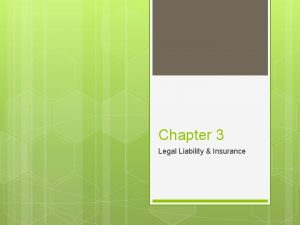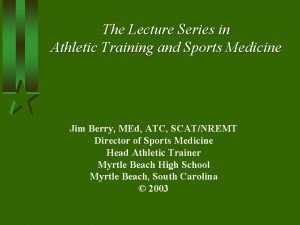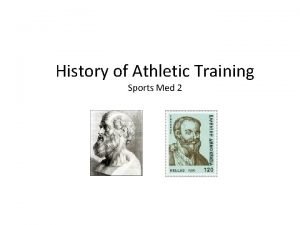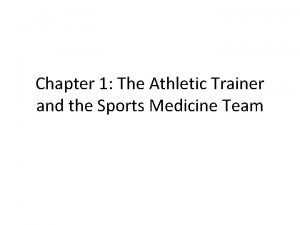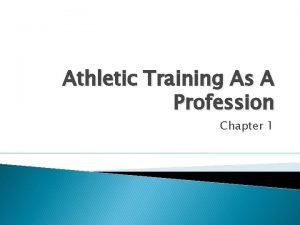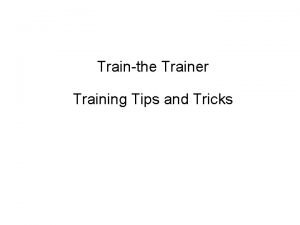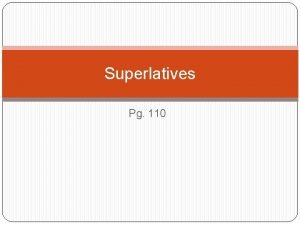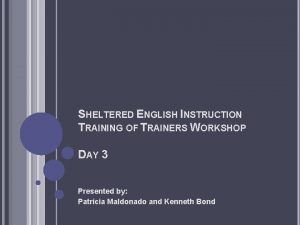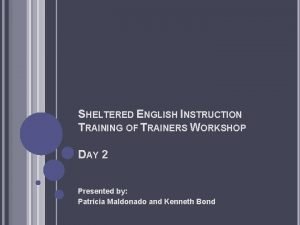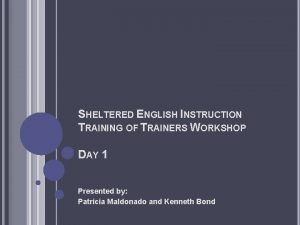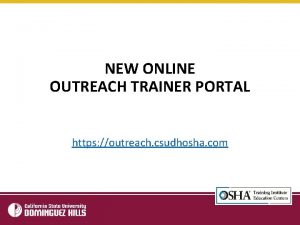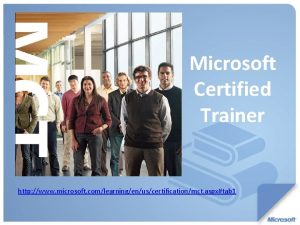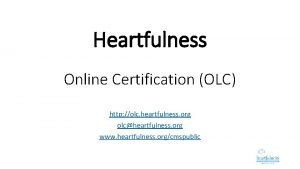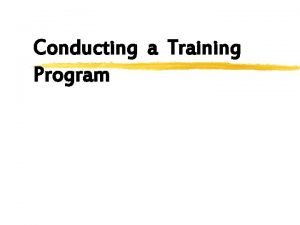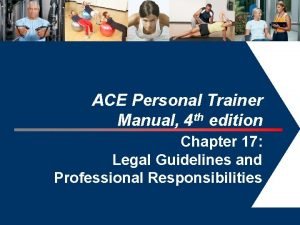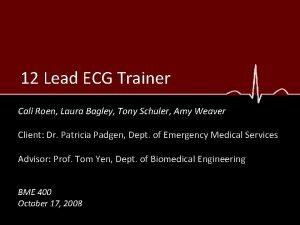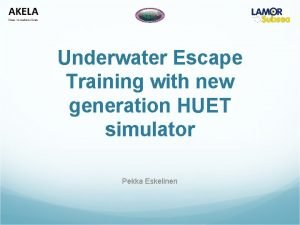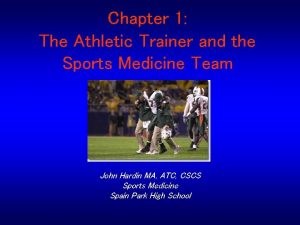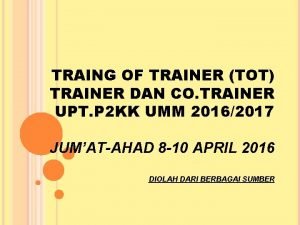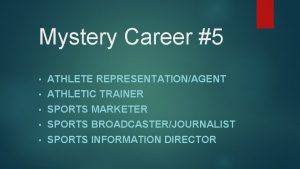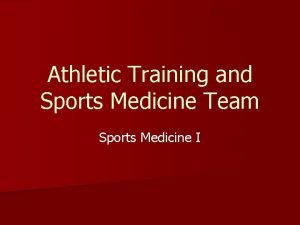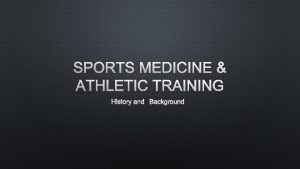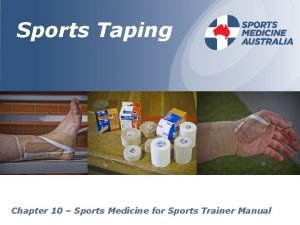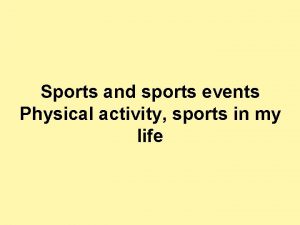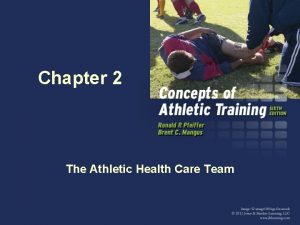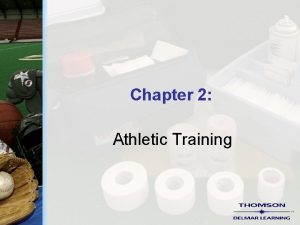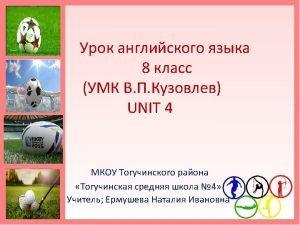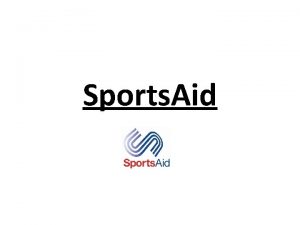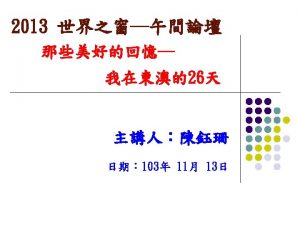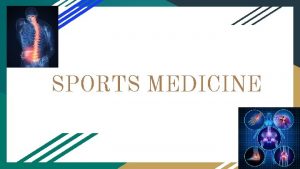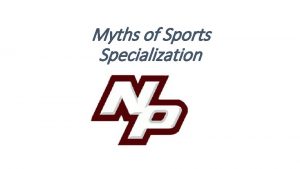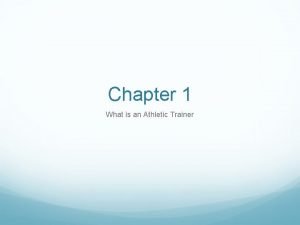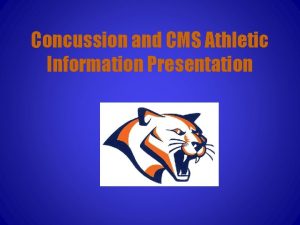Chapter 1 The Athletic Trainer and the Sports

























- Slides: 25

Chapter 1: The Athletic Trainer and the Sports Medicine Team

Sports Medicine • Broad field of medical practices related to physical activity and sport • Involves a number of specialties involving active populations • Typically classified as relating to performance enhancement or injury care and management

Human Performance Injury Management Exercise Physiology Practice of Medicine Biomechanics Sports Physical Therapy Sport Psychology Athletic Training Sports Nutrition Sports Massage

Sports Medicine • Where have we been? • Where are we now? • Where are we going?

Sports Medicine & Athletic Training • Traditional setting of practice included colleges and secondary schools – Dealing exclusively with an athletic population • Today certified athletic trainers (ATC) work in a variety of settings – Professional sports, hospitals, clinics, industrial settings, the military, equipment sales, physician extenders

• With the evolution of the profession a number of milestones have been achieved – Recognition of ATC’s as healthcare providers – Increased diversity of practice settings – Passage of practice acts – Third party reimbursement for athletic trainers – Constant revision and reform of athletic training education

National Athletic Trainers’ Association • To enhance the quality of health care for athletes and those engaged in physical activity, and to advance the profession of athletic training through education and research in the prevention, evaluation, management and rehabilitation of injuries • The NATA now has 30, 000 members

NCAA Committee on Competitive Safeguards and Medical Aspects of Sports • Collects and develops pertinent information regarding desirable training methods, prevention and treatment of sports injuries, and utilization of sound safety measures • Disseminates information and adopts recommended policies and guidelines designed to further the above objectives • Supervises drug-education and drug-testing programs

The Athletic Trainer • Charged with injury prevention and health care provision for the athlete • Athletic trainer deals with the athlete and injury from its inception until the athlete returns to full competition

Roles and Responsibilities: Performance Domains • • Prevention of athletic injuries Clinical evaluation and diagnosis Immediate care of injuries Treatment, rehabilitation and reconditioning of athletic injuries • Health care administration • Professional responsibilities

Personal Qualities of the Athletic Trainer • • • Stamina and the ability to adapt Empathy Sense of humor Communication Intellectual curiosity Ethical practice

Athletic Trainer and the Athlete • Major concern on the part of the ATC should be the athlete • All decisions impact the athlete • The injured athlete must always be informed – Be made aware of the how, when and why that dictates the course of injury rehabilitation

• The athlete must be educated about injury prevention and management • Instructions should be provided regarding training and conditioning • Inform the athlete to listen to his/her body in order to prevent injuries

Athletic Trainer and Parents • ATC must keep parents informed, particularly in the secondary school setting – Injury management and prevention • The parents decision regarding healthcare must be a primary consideration • Insurance plans may dictate care – Selection of physician

• ATC, physician and coaches must be aware and inform parents of Health Insurance Portability and Accountability Act (HIPAA) – Regulates dissemination of health information – Protects patient’s privacy and limits the people who could gain access to medical records

Responsibilities of the Team Physician • Athletic trainer works under direct supervision of physician • Physician assumes a number of roles – Serves to advise and supervise ATC • Physician and ATC must be able to work together – Have similar philosophical opinions regarding injury management • Helps to minimize discrepancies and inconsistencies

The Players on the Sports Medicine Team • • • Physicians Dentist Podiatrist Nurse Physicians Assistant Physical Therapist Athletic Trainer Massage Therapist Ophthalmologist Dermatologist Gynecologist • • • Exercise Physiologist Biomechanist Nutritionist Sport Psychologist Coaches Strength & Conditioning Specialist Social Worker Neurologist Osteopath Psychiatrist

• Settings include: – – – – – Secondary schools Colleges and universities Professional teams Sports medicine clinics Corporate/Industrial settings Military Physician extenders Medical supply & equipment sales Research Administration

Recognition and Accreditation of the Athletic Trainer as an Allied Health Professional • June 1990 - AMA officially recognized athletic training as an allied health profession • Committee on Allied Health Education and Accreditation (CAHEA) was charged with responsibility of developing essentials and guidelines for academic programs to use in preparation of individuals for entry into profession through the Joint Review Committee on Athletic Training (JRC-AT)

• June 1994 -CAHEA dissolved and replaced immediately by Commission on Accreditation of Allied Health Education Programs (CAAHEP) – Recognized as an accreditation agency for allied health education programs by the U. S. Department of Education • Entry level college and university athletic training education programs at both undergraduate and graduate levels are now accredited by CAAHEP

Requirements for Certification as an Athletic Trainer • Must have extensive background in formal academic preparation and supervised practical experience • Guidelines are set by the National Athletic Trainers’ Association Board of Certification (NATABOC)

• Upon meeting the educational guidelines applicants are eligible to sit for the examination • Examination consist of the following: – Written portion – Practical portion – Written simulation • Exam assesses the 6 domains – – – Prevention of injuries Evaluation and diagnosis Immediate care of injuries Treatment, rehabilitation & reconditioning Organization and administration Professional responsibility

• Upon passing the certification examination = BOC certification as an athletic trainer – Credential of ATC • BOC certification is a prerequisite for licensure in most states

Continuing Education Requirements • Ensure ongoing professional growth and involvement • Requirements that must be met to remain certified – 80 CEU’s over the course of three years

• Purpose: – To encourage ATC to obtain current professional development information – To explore new knowledge in specific areas – To master new athletic training related skill and techniques – To expand approaches to effective athletic training – To further develop professional judgement – To conduct professional practice in an ethical and appropriate manner
 Example of malfeasance in athletic training
Example of malfeasance in athletic training The athletic trainer is most directly responsible
The athletic trainer is most directly responsible Athletic trainer liability
Athletic trainer liability Herodicus of megara
Herodicus of megara Outdoor sports name
Outdoor sports name Chapter 1 athletic training as a profession
Chapter 1 athletic training as a profession Chapter 1 athletic training as a profession
Chapter 1 athletic training as a profession Trainthe trainer
Trainthe trainer Athletic comparative and superlative
Athletic comparative and superlative Good trainer qualities
Good trainer qualities Train the trainer course objectives
Train the trainer course objectives Luke trainer clark the boy who cried wolf
Luke trainer clark the boy who cried wolf Sheltered 2 trainer
Sheltered 2 trainer Sheltered trainer
Sheltered trainer Sheltered trainer
Sheltered trainer Ospfv
Ospfv Portal 2 trainer
Portal 2 trainer Microsoft certified trainer login
Microsoft certified trainer login Azure technical trainer
Azure technical trainer Heartfulness.org login
Heartfulness.org login Good trainer qualities
Good trainer qualities Ace personal trainer insurance
Ace personal trainer insurance 12 lead trainer
12 lead trainer Underwater escape room
Underwater escape room Siemens cooperates with education
Siemens cooperates with education Microsoft innovative educator trainer academy
Microsoft innovative educator trainer academy
